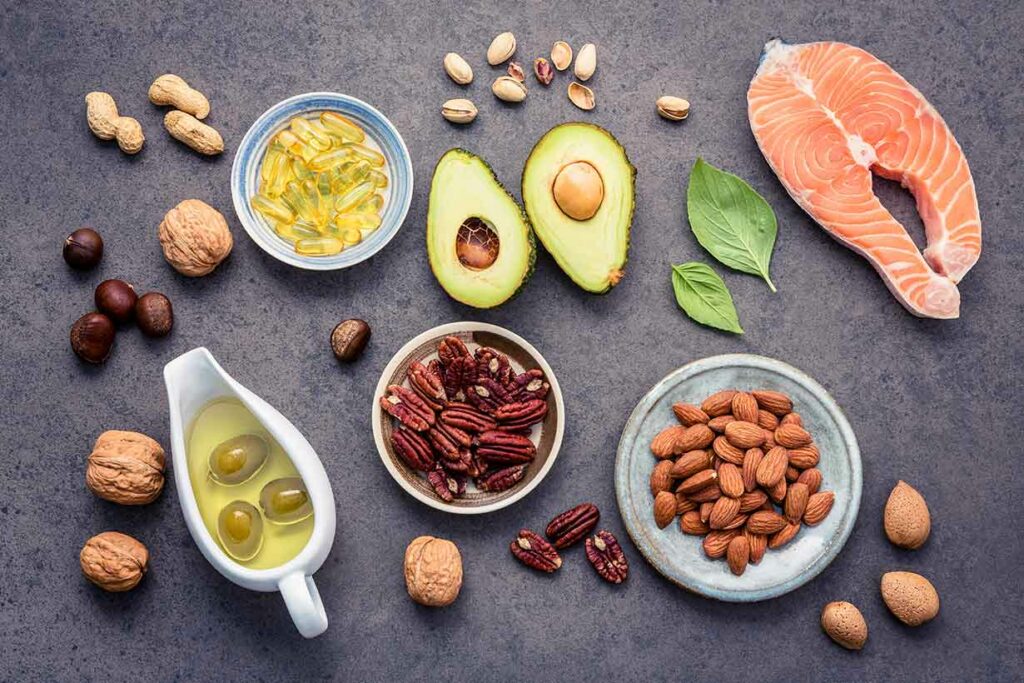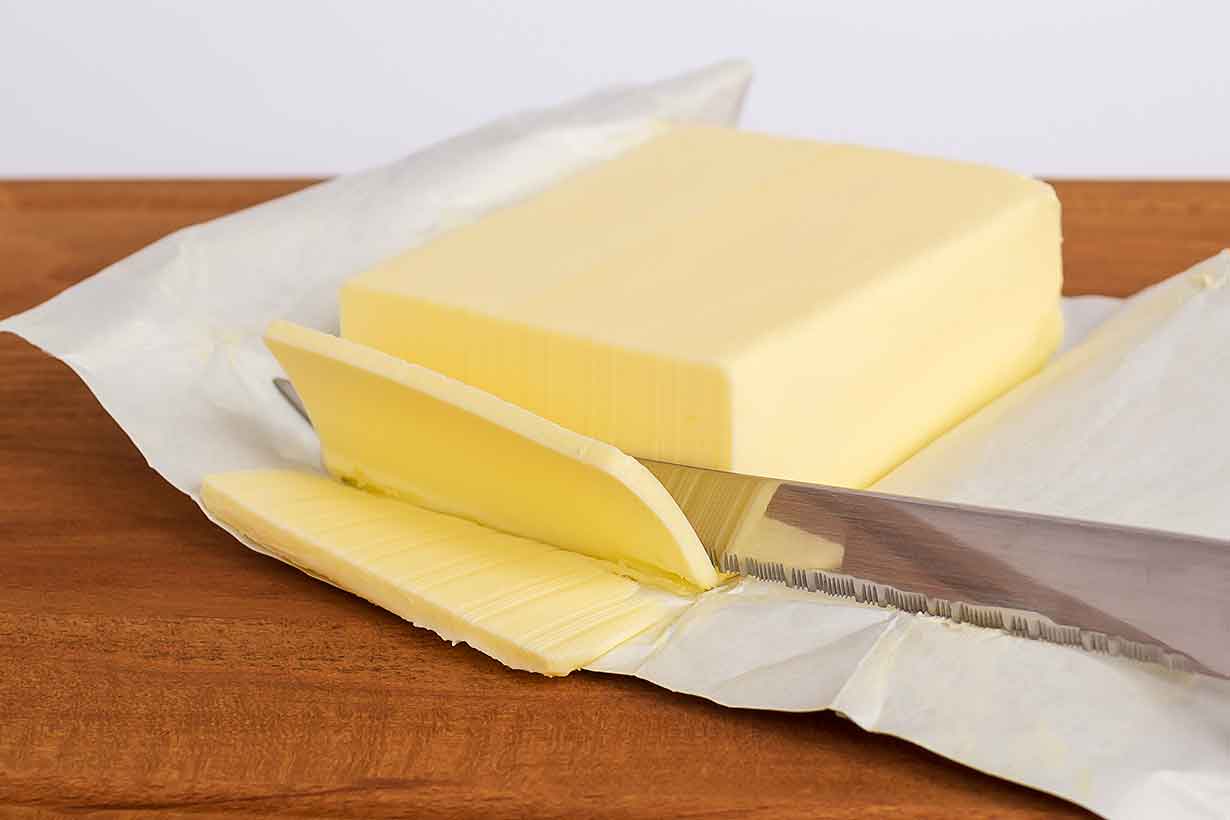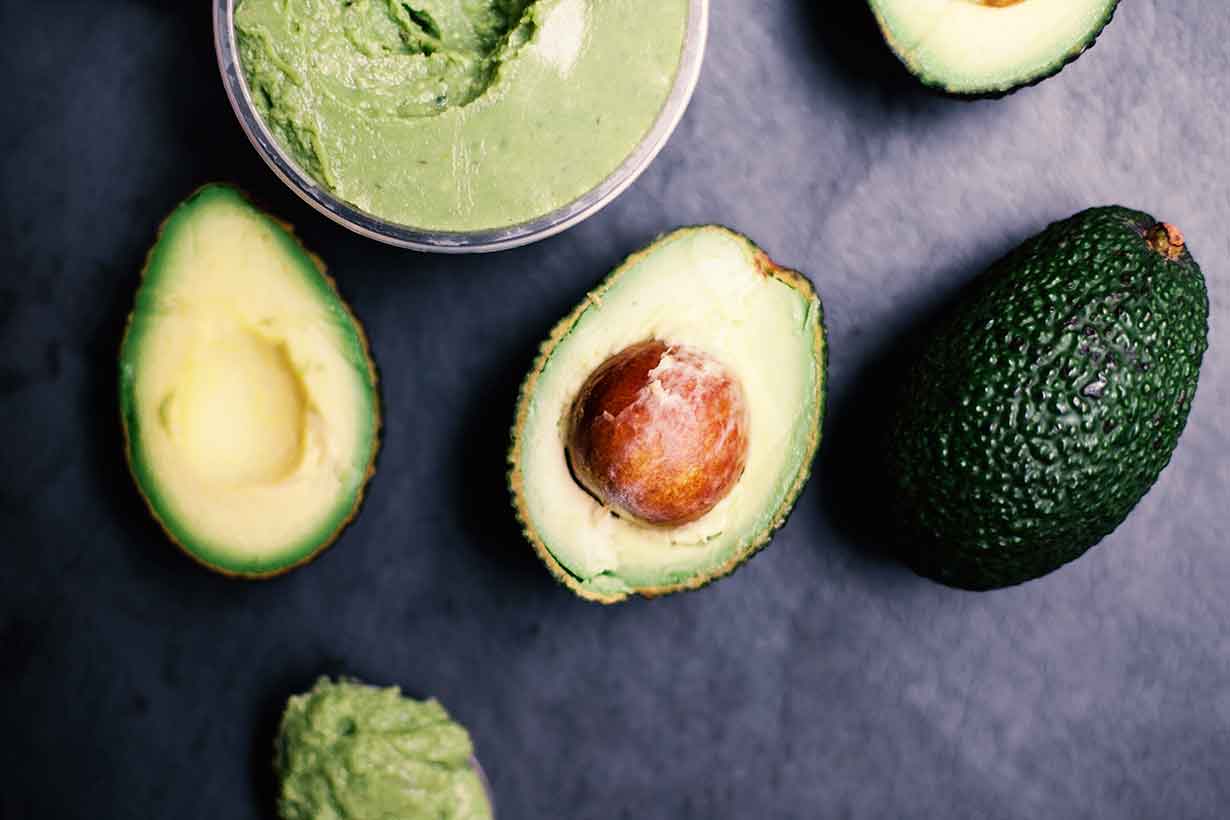There are many different food sources of dietary fat.
Each of these foods contains different types of fatty acids, specifically saturated, monounsaturated, polyunsaturated, omega-3, and omega-6 fatty acids.
In this regard, some people may be trying to limit their intake of particular fatty acids or increase their intake of others.
However, it can be challenging to determine which foods contain which fatty acids.
This guide presents the fatty acid profile of common foods, organized by food category. Additionally, the most concentrated fatty acid for each food will be highlighted in bold.
All nutritional data is from the USDA FoodData Central Database and the NCC Nutrition Database.
Values are ‘per 100 grams‘ for each food.

Table of contents
- Fatty Acid Profiles of Cocoa Products (Per 100g)
- Fatty Acid Profiles of Cooking Oils and Fats (Per 100g)
- Fatty Acid Profiles of Dairy Foods (Per 100g)
- Fatty Acid Profiles of Eggs (Per 100g)
- Fatty Acid Profiles of Fruit and Vegetables (Per 100g Raw Weight)
- Fatty Acid Profiles of Grains (Per 100g Raw Weight)
- Fatty Acid Profiles of Legumes (Per 100g Raw Weight)
- Fatty Acid Profiles of Meat and Poultry (Per 100g Raw Weight)
- Fatty Acid Profiles of Nuts and Seeds (Per 100g)
- Fatty Acid Profiles of Seafood (Per 100g Raw Weight)
- Notes
Fatty Acid Profiles of Cocoa Products (Per 100g)
The following table shows the fatty acid profiles for chocolate products. Chocolate tends to contain mainly saturated fatty acids.
| Name | Total Fat | Saturated | Monounsaturated | Polyunsaturated | Omega-3 | Omega-6 |
| Cocoa butter | 100g | 59.7g | 32.9g | 3.0g | 0.10g | 2.80g |
| Cocoa powder | 13.7g | 8.07g | 4.57g | 0.44g | 0.00g | 0.44g |
| Dark chocolate (70-85% cocoa) | 42.63g | 24.49g | 12.78g | 1.26g | 0.03g | 1.21g |
| Milk chocolate | 29.66g | 18.51g | 7.19g | 1.38g | 0.12g | 0.31g |
| White chocolate | 32.09g | 19.41g | 9.10g | 1.01g | 0.10g | 0.90g |
Fatty Acid Profiles of Cooking Oils and Fats (Per 100g)
The fatty acid profiles of cooking oils tend to vary widely depending on the oil or fat source.
Most animal-based fats tend to be highest in saturated and monounsaturated fat. Meanwhile, a lot of vegetable oils are predominantly polyunsaturated fat.
| Name | Total Fat | Saturated | Monounsaturated | Polyunsaturated | Omega-3 | Omega-6 |
| Avocado oil | 100g | 11.56g | 70.55g | 13.49g | 0.96g | 12.53g |
| Butter | 81.11g | 50.49g | 23.43g | 3.01g | 0.32g | 1.01g |
| Canola (rapeseed) oil | 100.0g | 7.37g | 63.28g | 28.14g | 9.14g | 18.64g |
| Canola, high oleic | 100.0g | 6.79g | 72.73g | 15.79g | 2.20g | 12.92g |
| Coconut oil | 99.06g | 82.48g | 6.33g | 1.70g | 0.02g | 1.70g |
| Corn oil | 100.0g | 12.95g | 27.58g | 54.68g | 1.16g | 53.23g |
| Cottonseed oil | 100.0g | 25.90g | 17.80g | 51.90g | 0.20g | 51.60g |
| Ghee | 99.48g | 61.92g | 28.73g | 3.69g | 1.45g | 1.24g |
| Goose fat | 99.80g | 27.70g | 56.70g | 11.0g | 0.50g | 9.80g |
| Grapeseed oil | 100.0g | 9.60g | 16.10g | 69.90g | 0.06g | 69.60g |
| Lard | 100.0g | 39.20g | 45.10g | 11.20g | 1.00g | 10.20g |
| Macadamia oil | 100.0g | 14.31g | 78.80g | 2.52g | 0.32g | 2.21g |
| Olive oil | 100.0g | 13.81g | 72.96g | 10.52g | 0.76g | 9.76g |
| Palm kernel oil | 100.0g | 81.50g | 11.40g | 1.60g | 0g | 1.60g |
| Peanut oil | 100.0g | 16.90g | 46.20g | 32.0g | 0g | 32.0g |
| Rice bran oil | 100.0g | 19.70g | 39.30g | 35.0g | 1.60g | 33.40g |
| Safflower oil | 100.0g | 6.20g | 14.36g | 74.62g | 0g | 74.62g |
| Safflower oil, high oleic | 100.0g | 7.54g | 75.22g | 12.82g | 0.10g | 12.72g |
| Sesame oil | 100.0g | 14.41g | 39.70g | 41.70g | 0.30g | 41.30g |
| Soybean oil | 100.0g | 15.65g | 22.78g | 57.74g | 6.79g | 50.42g |
| Sunflower oil | 100.0g | 10.30g | 19.50g | 65.70g | 0g | 65.70g |
| Sunflower oil, high oleic | 100.0g | 9.86g | 83.69g | 3.80g | 0.19g | 3.61g |
| Tallow (beef fat) | 100.0g | 49.80g | 41.80g | 4.00g | 0.60g | 3.10g |
| Vegetable shortening (Crisco) | 100.0g | 25.0g | 20.83g | 50.0g | 5.82g | 43.44g |
Fatty Acid Profiles of Dairy Foods (Per 100g)
Here are the fatty acid profiles for different dairy-based foods. Saturated fat tends to be the predominant fatty acid in dairy products.
| Name | Total fat | Saturated | Monounsaturated | Polyunsaturated | Omega-3 | Omega-6 |
| Butter | 81.11g | 50.49g | 23.43g | 3.01g | 0.32g | 1.01g |
| Buttermilk, whole | 3.31g | 1.90g | 0.83g | 0.20g | 0.08g | 0.10g |
| Buttermilk, 2% fat | 2.0g | 1.24g | 0.58g | 0.07g | 0.03g | 0.03g |
| Buttermilk, skim | 0.88g | 0.53g | 0.25g | 0.03g | 0.01g | 0.02g |
| Cheese, Brie | 27.68g | 17.41g | 8.01g | 0.83g | 0.31g | 0.14g |
| Cheese, Cheddar | 33.31g | 18.87g | 8.27g | 1.42g | 0.14g | 0.79g |
| Cheese, Cheddar, 50% reduced-fat | 15.76g | 9.00g | 4.08g | 0.68g | 0.07g | 0.46g |
| Cheese, Gouda | 27.44g | 17.61g | 7.75g | 0.66g | 0.39g | 0.26g |
| Cheese, Mozzarella | 24.64g | 15.56g | 7.03g | 0.78g | 0.21g | 0.25g |
| Cheese, Parmesan, fresh | 25.0g | 15.75g | 7.52g | 0.57g | 0.30g | 0.01g |
| Cheese, Parmesan, dried, grated | 27.84g | 15.37g | 7.13g | 1.39g | 0.12g | 0.87g |
| Cream cheese | 28.60g | 18.02g | 8.07g | 1.03g | 0.38g | 0.34g |
| Cream cheese, light | 16.67g | 8.95g | 4.00g | 0.58g | 0.08g | 0.32g |
| Milk, Whole | 3.25g | 1.87g | 0.81g | 0.20g | 0.08g | 0.07g |
| Milk, 2% fat | 1.96g | 1.26g | 0.56g | 0.07g | 0.01g | 0.05g |
| Milk, skim | 0.08g | 0.06g | 0.02g | <0.01g | <0.01g | <0.01g |
| Sour cream | 19.35g | 10.14g | 4.59g | 0.80g | 0.09g | 0.44g |
| Whey protein concentrate | 10.24g | 2.05g | 1.30g | 4.20g | 0.47g | 3.59g |
| Yogurt, Greek | 3.96g | 2.48g | 1.16g | 0.11g | 0.03g | 0.05g |
| Yogurt, Greek, low-fat | 1.95g | 1.22g | 0.57g | 0.06g | 0.02g | 0.03g |
| Yogurt, whole | 3.25g | 2.10g | 0.89g | 0.09g | 0.03g | 0.02g |
| Yogurt, low-fat | 1.55g | 1.00g | 0.43g | 0.04g | 0.01g | 0.03g |
Fatty Acid Profiles of Eggs (Per 100g)
Several different egg varieties exist, and monounsaturated fats are generally the primary fatty acids in eggs.
| Name | Total fat | Saturated | Monounsaturated | Polyunsaturated | Omega-3 | Omega-6 |
| Chicken egg | 9.51g | 3.13g | 3.66g | 1.91g | 0.10g | 1.58g |
| Duck egg | 13.77g | 3.68g | 6.53g | 0.86g | 0.07g | 0.39g |
| Goose egg | 13.27g | 3.60g | 5.75g | 1.67g | 0.55g | 0.68g |
| Quail egg | 11.09g | 3.56g | 4.32g | 1.32g | 0.04g | 0.94g |
| Turkey egg | 11.88g | 3.63g | 4.57g | 1.66g | 0.08g | 1.17g |
Fatty Acid Profiles of Fruit and Vegetables (Per 100g Raw Weight)
Here are the fatty acid profiles for fruit and vegetables that contain at least a small amount of dietary fat.
| Name | Total fat | Saturated | Monounsaturated | Polyunsaturated | Omega-3 | Omega-6 |
| Avocado | 14.66g | 2.13g | 9.80g | 1.82g | 0.11g | 1.69g |
| Coconut | 33.49g | 29.70g | 1.43g | 0.37g | 0.00g | 0.37g |
| Edamame (cooked) | 6.40g | 0.74g | 1.21g | 3.01g | 0.35g | 2.65g |
| Fava beans | 0.60g | 0.14g | 0.02g | 0.31g | 0.19g | 0.12g |
| Green peas | 0.40g | 0.07g | 0.04g | 0.19g | 0.04g | 0.0g |
| Jackfruit | 0.64g | 0.20g | 0.16g | 0.09g | 0.08g | 0.02g |
| Olives (green) | 15.32g | 2.03g | 11.31g | 1.31g | 0.09g | 1.22g |
| Olives (black) | 10.90g | 2.28g | 7.65g | 0.63g | 0.00g | 0.63g |
| Sweetcorn (canned and drained) | 1.22g | 0.25g | 0.37g | 0.52g | 0.02g | 0.14g |
Fatty Acid Profiles of Grains (Per 100g Raw Weight)
Although they are predominantly a source of carbohydrates, grains do contain small amounts of fat.
Here are the fatty acid profiles for some of the most common whole-grain varieties.
| Name | Total fat | Saturated | Monounsaturated | Polyunsaturated | Omega-3 | Omega-6 |
| Amaranth | 7.02g | 1.46g | 1.69g | 2.78g | 0.04g | 2.74g |
| Brown rice | 2.68g | 0.54g | 0.97g | 0.96g | 0.04g | 0.92g |
| Buckwheat | 3.40g | 0.74g | 1.04g | 1.04g | 0.08g | 0.96g |
| Millet | 4.22g | 0.72g | 0.77g | 2.13g | 0.12g | 2.02g |
| Oats | 6.52g | 1.11g | 1.98g | 2.30g | 0.10g | 2.20g |
| Quinoa | 6.07g | 0.71g | 1.61g | 3.29g | 0.31g | 2.98g |
| Sorghum | 3.46g | 0.61g | 1.13g | 1.56g | 0.07g | 1.49g |
| Teff | 4.59g | 0.87g | 1.14g | 2.07g | 0.26g | 1.81g |
| Whole wheat flour | 2.50g | 0.43g | 0.28g | 1.17g | 0.07g | 1.09g |
| Wild rice | 1.08g | 0.16g | 0.16g | 0.68g | 0.30g | 0.38g |
Fatty Acid Profiles of Legumes (Per 100g Raw Weight)
Most legumes contain at least a small amount of dietary fat. However, some legumes, such as lupin beans and soybeans, provide substantial amounts of fat.
Here are the fatty acid profiles of some common legumes.
| Name | Total fat | Saturated | Monounsaturated | Polyunsaturated | Omega-3 | Omega-6 |
| Black beans | 1.42g | 0.37g | 0.12g | 0.61g | 0.28g | 0.33g |
| Black-eyed peas | 1.26g | 0.33g | 0.11g | 0.54g | 0.20g | 0.34g |
| Lentils | 1.06g | 0.15g | 0.19g | 0.53g | 0.11g | 0.41g |
| Lima beans | 0.69g | 0.16g | 0.06g | 0.31g | 0.10g | 0.22g |
| Lupin beans | 9.74g | 1.16g | 3.94g | 2.44g | 0.45g | 2.00g |
| Mung beans | 1.15g | 0.35g | 0.16g | 0.38g | 0.03g | 0.36g |
| Navy beans | 1.50g | 0.17g | 0.13g | 0.87g | 0.54g | 0.34g |
| Pinto beans | 1.23g | 0.24g | 0.23g | 0.41g | 0.24g | 0.17g |
| Soybeans | 19.94g | 2.88g | 4.40g | 11.26g | 1.33g | 9.93g |
| Split peas | 0.68g | 0.12g | 0.06g | 0.33g | 0.06g | 0.00g |
Fatty Acid Profiles of Meat and Poultry (Per 100g Raw Weight)
The primary fatty acids in meat and poultry tend to be saturated and monounsaturated fats.
However, the fat content can significantly vary depending on how the animal was fed, and whether the meat is a lean or fatty cut.
| Name | Total fat | Saturated | Monounsaturated | Polyunsaturated | Omega-3 | Omega-6 |
| Beef, ground, 80% lean | 20.0g | 7.58g | 8.85g | 0.52g | 0.05g | 0.44g |
| Beef, ground, 95% lean | 5.00g | 2.18g | 1.99g | 0.26g | 0.03g | 0.19g |
| Beef kidney | 4.65g | 1.44g | 0.96g | 1.14g | 0.01g | 1.08g |
| Beef liver | 5.26g | 2.95g | 1.12g | 1.11g | 0.02g | 1.08g |
| Bison, ground | 15.93g | 6.80g | 6.22g | 0.75g | 0.08g | 0.58g |
| Chicken breast, skinless | 4.51g | 1.27g | 1.54g | 0.98g | 0.10g | 0.82g |
| Chicken breast, skin | 7.42g | 2.08g | 2.90g | 1.58g | 0.10g | 1.41g |
| Chicken drumstick | 9.95g | 2.93g | 3.59g | 2.87g | 0.17g | 2.60g |
| Chicken thigh | 16.61g | 4.52g | 6.94g | 3.47g | 0.17g | 3.12g |
| Duck, meat and skin, domestic | 39.34g | 13.22g | 18.69g | 5.08g | 0.39g | 4.69g |
| Duck, skinless, domestic | 5.95g | 2.32g | 1.54g | 0.75g | 0.08g | 0.67g |
| Duck, meat and skin, wild | 12.10g | 3.91g | 5.63g | 1.19g | 0.01g | 1.06g |
| Duck, skinless, wild | 4.25g | 1.32g | 1.21g | 0.58g | 0.07g | 0.51g |
| Goose, meat and skin, domestic | 33.62g | 9.78g | 17.77g | 3.76g | 0.21g | 3.34g |
| Goose meat, skinless, domestic | 7.13g | 2.79g | 1.85g | 0.90g | 0.10g | 0.80g |
| Lamb, loin chop | 26.19g | 11.16g | 7.47g | 0.97g | 0.31g | 0.27g |
| Lamb, ground, 85% lean | 20.71g | 9.93g | 7.95g | 1.12g | 0.32g | 0.42g |
| Pork belly | 53.01g | 19.33g | 24.70g | 5.65g | 0.48g | 5.03g |
| Pork chop, loin | 15.15g | 5.35g | 6.68g | 1.30g | 0.01g | 1.17g |
| Pork, ground, 84% lean | 16.0g | 4.93g | 6.68g | 2.05g | 0.12g | 1.90g |
| Pork, ground, 96% lean | 4.0g | 1.42g | 1.89g | 0.66g | 0.04g | 0.56g |
| Turkey breast, with skin | 7.42g | 2.08g | 2.90g | 1.58g | 0.10g | 1.41g |
| Turkey breast, skinless | 2.08g | 0.59g | 0.63g | 0.53g | 0.03g | 0.47g |
| Turkey, ground, 85% lean | 12.54g | 3.41g | 4.55g | 3.49g | 0.20g | 3.09g |
| Turkey, ground, 93% lean | 8.34g | 2.17g | 2.84g | 2.54g | 0.15g | 2.22g |
Fatty Acid Profiles of Nuts and Seeds (Per 100g)
With the exception of chestnuts, most nuts and seeds have a high fat content.
Depending on the type of nut or seed, either monounsaturated or polyunsaturated fatty acids are the main fatty acids.
| Name | Total fat | Saturated | Monounsaturated | Polyunsaturated | Omega-3 | Omega-6 |
| Acorns | 23.86g | 3.10g | 15.11g | 4.60g | – | 4.60g |
| Almonds | 49.93g | 3.80g | 31.55g | 12.33g | 0.01g | 12.32g |
| Brazil nuts | 67.10g | 16.13g | 23.88g | 24.40g | 0.02g | 23.88g |
| Cashew nuts | 43.85g | 7.78g | 23.80g | 7.85g | 0.06g | 7.78g |
| Chestnuts | 3.91g | 0.74g | 1.35g | 1.55g | 0.17g | 1.38g |
| Chia seeds | 30.74g | 3.78g | 2.31g | 23.67g | 17.83g | 5.84g |
| Flax seeds | 42.16g | 3.66g | 7.53g | 28.73g | 22.81g | 5.90g |
| Hemp seeds | 35.50g | 2.94g | 3.83g | 24.50g | 7.08g | 17.35g |
| Hickory nuts | 64.37g | 7.04g | 32.61g | 21.89g | 1.05g | 20.62g |
| Macadamia nuts | 75.77g | 12.06g | 58.88g | 1.50g | 0.21g | 1.30g |
| Peanuts | 49.24g | 6.28g | 24.43g | 15.56g | 0.01g | 15.52g |
| Pecans | 71.97g | 6.18g | 40.80g | 21.61g | 0.99g | 20.63g |
| Pili nuts | 68.37g | 4.90g | 18.76g | 34.07g | 0.11g | 33.61g |
| Pistachio nuts | 45.32g | 5.91g | 23.26g | 14.38g | 0.29g | 14.09g |
| Poppy seeds | 41.56g | 4.52g | 5.98g | 28.57g | 0.27g | 28.29g |
| Pumpkin seeds | 49.05g | 8.54g | 15.73g | 19.86g | 0.11g | 19.56g |
| Sesame seeds | 49.67g | 6.96g | 18.76g | 21.77g | 0.38g | 21.37g |
| Sunflower seeds | 51.46g | 4.46g | 18.53g | 23.14g | 0.09g | 23.05g |
| Walnuts | 65.21g | 6.13g | 8.93g | 47.17g | 9.08g | 38.09g |
| Watermelon seeds | 47.37g | 9.78g | 7.41g | 28.09g | 0.00g | 28.09g |
Fatty Acid Profiles of Seafood (Per 100g Raw Weight)
Seafood can be quite lean or fatty, depending on the specific type of fish. Additionally, fatty seafood provides the best dietary source of omega-3 fatty acids.
Here are the fatty acid profiles for various common seafood options.
| Name | Total fat | Saturated | Monounsaturated | Polyunsaturated | Omega-3 | Omega-6 |
| Abalone | 0.76g | 0.15g | 0.11g | 0.10g | 0.09g | 0.01g |
| Anchovies | 4.84g | 1.28g | 1.18g | 1.64g | 1.48g | 0.10g |
| Catfish (farmed) | 7.19g | 1.59g | 3.12g | 1.35g | 0.17g | 1.01g |
| Catfish (wild) | 2.85g | 0.74g | 1.10g | 0.64g | 0.42g | 0.20g |
| Clams | 0.96g | 0.12g | 0.12g | 0.19g | 0.13g | 0.04g |
| Conch (cooked) | 1.20g | 0.37g | 0.33g | 0.27g | 0.12g | 0.05g |
| Crab | 1.08g | 0.22g | 0.19g | 0.39g | 0.32g | 0.01g |
| Crayfish | 1.20g | 0.18g | 0.24g | 0.37g | 0.20g | 0.15g |
| Eel | 11.66g | 2.36g | 7.19g | 0.95g | 0.65g | 0.20g |
| Fish roe | 6.42g | 1.46g | 1.66g | 2.66g | 2.43g | 0.03g |
| Herring | 9.04g | 2.04g | 3.74g | 2.13g | 1.73g | 0.13g |
| Lobster | 0.75g | 0.18g | 0.22g | 0.30g | 0.22g | 0.04g |
| Mackerel | 13.89g | 3.26g | 5.46g | 3.35g | 2.67g | 0.22g |
| Mussels | 2.24g | 0.43g | 0.51g | 0.61g | 0.52g | 0.08g |
| Octopus | 1.04g | 0.23g | 0.16g | 0.24g | 0.16g | 0.01g |
| Oysters | 2.30g | 0.51g | 0.36g | 0.89g | 0.82g | 0.06g |
| Sablefish | 15.30g | 3.20g | 8.06g | 2.04g | 1.66g | 0.17g |
| Salmon (Atlantic, farmed) | 13.42g | 3.05g | 3.77g | 3.89g | 2.51g | 0.98g |
| Salmon (Atlantic, wild) | 6.34g | 0.98g | 2.10g | 2.54g | 2.02g | 0.17g |
| Sardines | 10.40g | 3.00g | 2.90g | 3.10g | 2.60g | 0.20g |
| Shrimp | 0.51g | 0.10g | 0.09g | 0.15g | 0.07g | 0.04g |
| Sprats | 6.53g | 1.47g | 2.70g | 1.54g | 1.38g | 0.16g |
| Squid | 1.38g | 0.36g | 0.11g | 0.52g | 0.50g | 0.01g |
| Striped bass | 2.33g | 0.51g | 0.66g | 0.78g | 0.77g | 0.02g |
| Swordfish | 6.65g | 1.61g | 3.00g | 1.15g | 0.94g | 0.07g |
| Tuna (light, canned in water) | 0.96g | 0.21g | 0.11g | 0.28g | 0.23g | 0.02g |
| Tuna (white, canned in water) | 2.97g | 0.79g | 0.78g | 1.11g | 0.95g | 0.06g |
| Tuna, bluefin | 4.90g | 1.26g | 1.60g | 1.43g | 1.30g | 0.05g |
| Tuna, skipjack | 1.01g | 0.33g | 0.19g | 0.32g | 0.27g | 0.02g |
| Tuna, yellowfin | 0.49g | 0.17g | 0.12g | 0.15g | 0.11g | 0.01g |
Notes
- All nutritional values are courtesy of the USDA FoodData Central Database and NCC Nutrition Database. These are the two of the most reliable major nutrition databases.
- Plant foods can vary depending on the growing conditions. Additionally, animal-based foods can vary nutritionally depending on how the animals were fed, and how lean the food is. In other words: although the values should be very accurate, food can vary slightly from one sample to another.
- Knowing the fatty acid profile of a particular food can be very useful. However, dietary decisions should be based on all the nutrients a food offers, as well as the overall diet.




